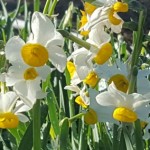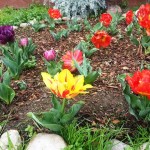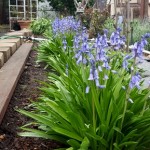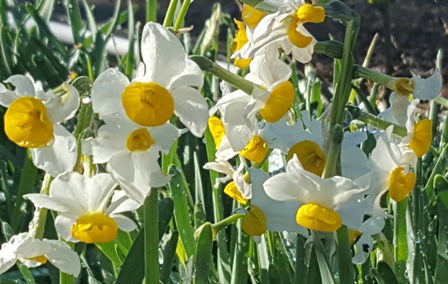Nature Dresses in Dramatic Colors for Spring
Many Northern California gardens are beginning to awaken in a riot of color from bulbs planted in the fall. Local gardeners will tell you that to achieve lots of color in a spring garden, you can’t beat blooming tulip, daffodil, hyacinth, allium, crocus, anemone, and ranunculus bulbs.
Buried in the earth, the bulbs are growing and sprouting and colonizing throughout winter. Many bulbs naturalize and spread year over year. One of my favorites is the deep blue Siberian Squill (Scilla siberica). The plant comes from the family of asperagaceae and thrives in Zones 2-8.
Bright green foliage appears first. Later, tight little buds open atop sturdy, straight stems. Each flower yields a bell-shaped bloom that is roughly one-half inch wide. It is only slightly fragrant. When established, three to five flowers form a stunning blue cluster on a six-inch stalk poking above sword-like foliage.
It’s best to plant these bulbs about six inches apart and three inches deep in early fall. Choose a spot in full sun or part shade. Siberian squill require medium amounts of water. For the greatest impact, do mass plantings under deciduous shrubs and trees or in circles or rows.

Masses of blooming daffodils provide a focus and cheery greeting in a bleak late winter or early spring garden
When planted near yellow daffodils, the rich blue color of the Siberian squill will really pop. These bulbs do not need to be lifted as they will naturalize and colonize over the years. And come spring each year, you will have dramatic color combinations sprouting all around your garden.
_________________________________________________
If you enjoy reading about gardening or farming topics, keeping chickens and bees, caring for fruit trees and vegetable gardens, or living well, check out my Henny Penny Farmette series of mysteries from Kensington Publishing and my health and wellness books from Adams Media/Simon and Schuster. The mysteries contain end-of-chapter tips on beekeeping and related topics. The rituals and meditation books feature tips and strategies for living your best peaceful life now.

More than 150 rituals for sound mind, strong body, and meaningful connections to the people around you
Critter-proofing Your Bulbs
I planted bagfuls of tulips, daffodils, crocus, and grape hyacinths over the last two years in the autumn. The daffodils are blooming now and the other bulbs in my garden have plenty of foliage.
Because voles, moles, gophers, squirrels, raccoons, and other critters will dig and eat the bulbs and deer will devour the blooms at first blush of color, a savvy gardener must figure out how to protect these beautiful flowers.

The bees are drawn to the sweet scent of narcissus that have now naturalized in my Henny Penny Farmette gardens
Throughout the Midwest of my youth, hillsides, front yards, and cemeteries were always places where daffodils grew in perfusion. Along with the arrival of robins and other songbirds, these flowering bulbs herald the coming light and warmth of spring. I’ve lost plenty of these plantings myself so have some tips to help you prevent such a loss.
Seven ways to protect flowering bulbs.
1. Grow them behind a double fence barrier. Deer can jump high and might go over one fence, but not a second one built near the first.
2. Use mesh to deter moles, voles, gophers, groundhogs, and other digging critters.
3. Erect fences that are at least three feet tall and with at least a foot buried beneath the earth.
4. Plant in raised beds covered with mesh. The bulbs will be protected while the foliage and blooms poke through toward the light.
5. Clean up the area in the fall after planting the bulbs. That way, critters won’t be attracted to your bulb beds.
6. Consider using deer-repellent sprays on tulips and growing deer-resistant bulbs.
7. Use ammonia-soaked rags in coffee cans or old planting buckets around the garden to repel pests with a keen sense of smell such as rabbits and opossums.
* * *
Enjoy reading about farming topics? Check out my cozy mysteries–A BEELINE TO MURDER and also THE MURDER OF A QUEEN BEE (both in the Henny Penny Farmette series from Kensington Publishing). Kobo Books has A BEELINE TO MURDER on sale. Check out this incredible deal on https://www.kobo.com/us/en/search?Query=Meera+Lester
My farmette and bee-based novels are chocked full of recipes, farming tips, chicken and beekeeping tips, sayings and, of course, a charming cozy mystery. For more info, click on the links under the pictures.
The books are available through online retailers such as Amazon, Barnes & Noble, Target, BAM, Kobo Books, and Walmart as well as from traditional bookstores everywhere.
See, http://tinyurl.com/hxy3s8q
A Beeline to Murder is the debut novel that launched the Henny Penny Farmette series of mysteries. Initially released as a hardcover novel and in e-book format, it is now available as a mass market paperback.
See, http://tinyurl.com/h4kou4g
NEWLY RELEASED! This, the second cozy mystery in the Henny Penny Farmette series, is garnering great reviews from readers and industry publications.
Tis the Season to Plant Bulbs for Spring/Summer Bloom
- These fragrant lilies return every year and bloom mid-summer
After the recent rainstorm, I walked around my farmette and noticed small slivers of green sprouting up. They seemed to be everywhere.
I could understand the grass coming back, but the sight of summer-blooming lilies shooting through the soil was quite surprising. The sight of them got me to thinking about planting some bulbs for a springtime bloom.

The bees are drawn to the sweet scent of narcissus that have naturalized in the yard and bloom in the spring
Over the weekend, I dug a bed for some tulips and planted nearly 100 bulbs–some early and others late-blooming.
I also will plant some sweetly fragrant grape hyacinth. The bees are attracted to the pollen because of the scent. Honeybees especially love foraging for pollen on violet-hued tulips.
Honeybees need to find pollen all through the year, so planting bulbs that bloom before the spring wildflowers makes sense for those of us who care about the bees.
For tips on farming, raising chickens, keeping honeybees, and creating farm crafts as well as having a good mystery to solve, check out my novel, A BEELINE TO MURDER. It’s available everywhere and also online at Amazon.com and barnesandnoble.com.

 Facebook
Facebook Goodreads
Goodreads LinkedIn
LinkedIn Meera Lester
Meera Lester Twitter
Twitter












